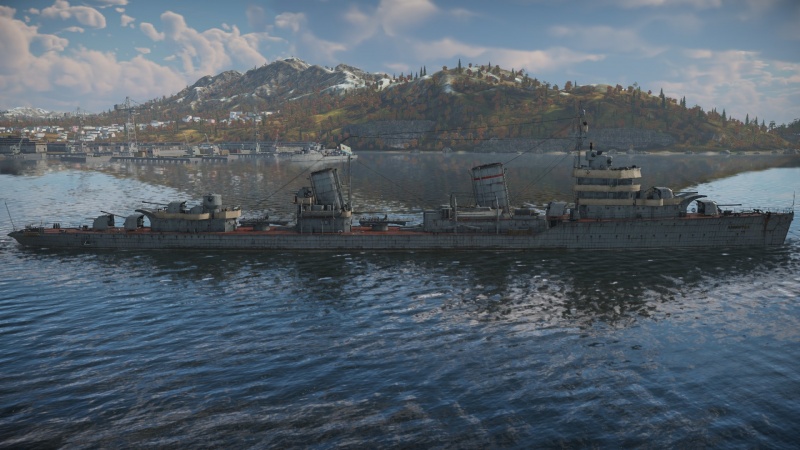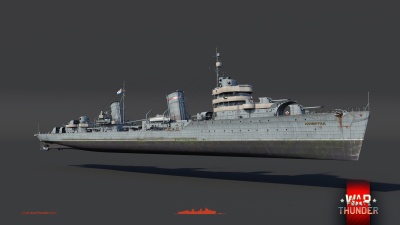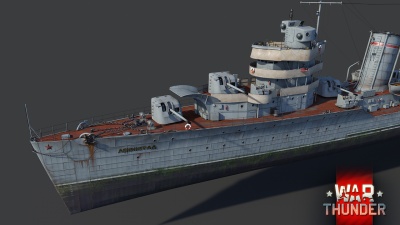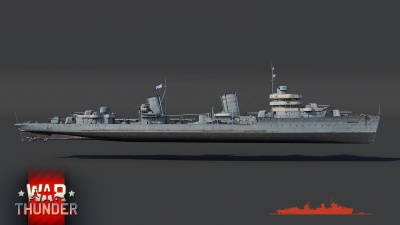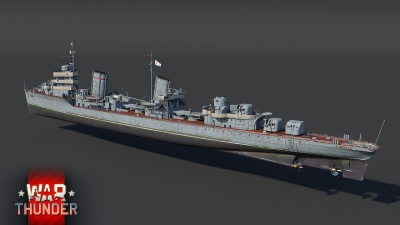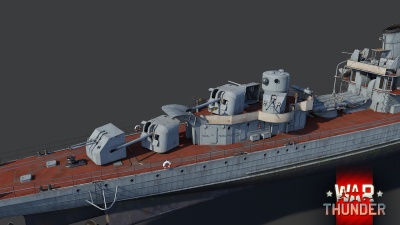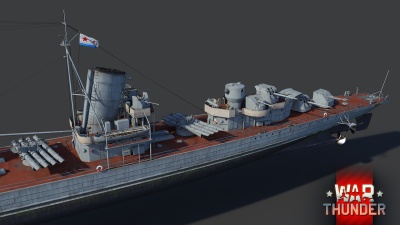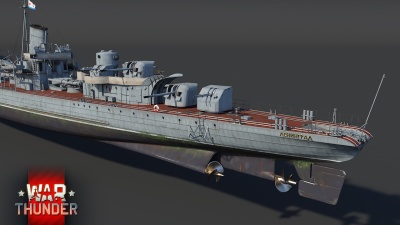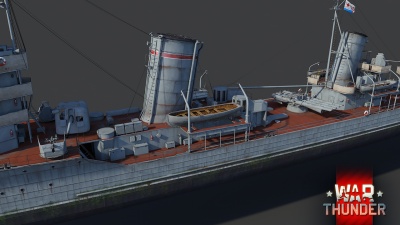Difference between revisions of "Leningrad"
(→General info: Mobility, Survivability, Pros/Cons) (Tag: Visual edit) |
m (→Pros and cons) |
||
| Line 74: | Line 74: | ||
* Main cannons are quite accurate and have a high muzzle velocity (870 m/s) | * Main cannons are quite accurate and have a high muzzle velocity (870 m/s) | ||
* Powerful secondary & anti-aircraft weapons suite | * Powerful secondary & anti-aircraft weapons suite | ||
| − | |||
| − | |||
'''Cons:''' | '''Cons:''' | ||
| Line 84: | Line 82: | ||
** Firing angles are non-ideal, as the only time all 5 guns can fire together is in a complete broadside | ** Firing angles are non-ideal, as the only time all 5 guns can fire together is in a complete broadside | ||
* Mediocre torpedoes with a range of 4 km without the torpedo mode modification | * Mediocre torpedoes with a range of 4 km without the torpedo mode modification | ||
| − | |||
| − | |||
== History == | == History == | ||
Revision as of 00:20, 26 December 2021
Contents
Description
The Leningrad-class, Leningrad, 1944 is a premium gift rank Soviet destroyer with a battle rating of (AB), (RB), and (SB). It was introduced during Update 1.85 "Supersonic" as part of the 2019 Sea Voyage event.
General info
Survivability and armour
The Leningrad has good survivability for a destroyer. First, it has a very high crew count of 344 crew members. Second, the ship's vital components are primarily located under the waterline making them harder to hit. However, the engine blocks are partially exposed, meaning that this ship can have its engines knocked out quite easily. Each of the five main cannons also have a ready-rack of 20 shells located beside the gun, which can be detonated with accurate fire. As with most destroyers, the Leningrad lacks armour on the hull, the only armour being thin anti-fragmentation armour on the gun turrets.
Mobility
As with the Moskva, its sister-ship, the Leningrad is extremely mobile. The main highlight of the Leningrad's mobility is its top speed: 80 kph (43 kts) in realistic and 107 kph in arcade! This destroyer is among the fastest in the game, and can rush to bases faster than any other destroyer. However, Leningrad's acceleration, turning circle and rudder shift are pretty mediocre among ships of its class.
| Mobility Characteristics | |||
|---|---|---|---|
| Game Mode | Upgrade Status | Maximum Speed (km/h) | |
| Forward | Reverse | ||
| AB | |||
| Upgraded | |||
| RB/SB | |||
| Upgraded | |||
Modifications and economy
Armament
Primary armament
The Leningrad carries five 130 mm (5.1 inch) B-13 guns in single open mountings. Two of the mountings are mounted fore of the superstructure, two are mounted aft, and one is mounted in a rather inconvenient position behind the bridge that only allows it to fire on broadsides.
The B-13 cannon is shared by most WWII-era destroyers of the Soviet fleet, and is a very potent weapon. However, the main flaw with this weapon is its absolutely horrid turret rotation speed of 4.2 degrees/second vertically and horizontally. This means that you have to turn the turrets very early to be able to engage effectively. The guns themselves shoot accurately and have a high initial velocity (870 m/s compared to 790 m/s for the American 5"/38 guns). However, this comes at the expense of reload speed, as the manually-loaded weapons can only fire at 10 rounds per minute (RPM) with a spaded crew, compared to 22 RPM for the American 5"/38. In fact, this fire rate is slower than everything except for the Japanese and Italian 5" guns, which have a similar fire rate.
The guns themselves have access to three shell types: the OF-46 high-explosive (HE) shell, the PB-46A semi armour-piercing (SAPBC) shell, and the ZS-46R proximity-fuzed (HE-VT) shell. Of these weapons, the HE shell is usually the best against enemy destroyers and ships as it packs the most explosive filler, 3.58 kilograms of it to be exact. The SAPBC shell works better against the occasional cruiser you may encounter, as it packs more penetration capacity (up to 179 mm compared to 36 mm for the HE shell). Finally, the HE-VT shell is good against aircraft as it will explode when close enough to the enemy aircraft, meaning that it doesn't require a direct hit. However, it actually packs less explosive filler than the normal HE shell, which is unusual for any HE-VT shell. Combined with the horrible traverse rate, this means the guns aren't particularly suited for anti-aircraft duties.
Secondary armament
The Leningrad carries a secondary armament of four 76 mm (3 inch) 34-K guns in two single mountings and one dual mounting, all placed at the very rear of the vessel. The 34-K is also shared by most WWII-era Soviet ships, and gives you a potent secondary weapon that is of a relatively high calibre. This gun has a high fire rate of 27 rounds per minute (2.2-second reload), which can be decreased to 1.1 seconds with a full crew. The weapon itself is decent at closer ranges, but isn't a particularly effective anti-aircraft weapon as it inherits the extremely weak Soviet traverse rate. The single mountings themselves are only capable of traversing at 10 degrees per second, marginally faster than guns of cruiser calibre (6 inch+) of other nations.
The gun itself has access to three main shell types - the O-361K high-explosive (HE) shell, the O-361D time-fuzed (HE-TF) shell, and the BR-361 armour-piercing (APHEBC) shell. Of these rounds, the HE is almost always the best against enemy boats as it has the most explosive filler, and consequently, does the most damage. The HE-TF round is slightly worse as it detonates on a timed fuze, meaning the accuracy of the shell depends on crew skills. Finally, the APHEBC shells are rarely usable due to their low damage potential. For good measure, bring mostly HE, and a bit of HE-TF and APHEBC just in case the situation arises.
Anti-aircraft armament
The Leningrad's six 37 mm 70-Ks serve as the main component of its anti-aircraft armament. The 70-K is the standard Soviet anti-aircraft gun and serves as a reliable counterpart to the 40 mm Bofors gun used by the allied nations. This gun is extremely similar to the Bofors as it features a similar design, and fires continuously rather than needing to reload. The guns will eventually jam, but the time it takes to jam the weapons is very long so jamming is not a great issue. The weapon does not get access to belts, but the default one is very suited for ripping small ships or aircraft into shreds.
The Leningrad also carries six DShK guns. The 12.7 mm DShK machine gun is a heavy machine gun, similar to the M2 Browning used by the Americans and the Vickers guns used by the British. This gun fires from a fixed 50-round magazine and will need to be reloaded after the magazine is expended. The gun itself is rather mediocre, and will struggle to hit targets reliably at ranges exceeding 1.5 km. As well, the weapon doesn't do damage particularly well, considering that it is of a lower calibre. The Leningrad does not get access to any ammunition belt upgrades - the default one is the only belt available.
Additional armament
The Leningrad gets access to two 53-38 quad launchers allowing a total of up to eight torpedoes in one salvo. The 53-38 torpedo is also found on most other Soviet WWII-era destroyers, and is relatively mediocre as far as torpedoes go. In terms of damage-dealing capabilities, the torpedo is decidedly mediocre, having more explosive filler (300 kg of TNT) than the American torpedoes but less than the British and Japanese ones. However, the main drawback of the torpedo is its range - without the "torpedo mode" modification, the 53-38s are restricted to a range of just 4 kilometres, meaning that they are tied for the shortest-range bluewater-ship mounted torpedoes along with the Italian destroyer torpedoes. The torpedo mode modification is necessary for hitting longer-ranged targets, but reduces the torpedo's speed to just 56 km/h. In general, these torpedoes are a potent weapon against enemy bluewater ships, but lack the range to do significant damage without the "torpedo mode" modification.
Usage in battles
Describe the technique of using this ship, the characteristics of her use in a team and tips on strategy. Abstain from writing an entire guide – don't try to provide a single point of view, but give the reader food for thought. Talk about the most dangerous opponents for this vehicle and provide recommendations on fighting them. If necessary, note the specifics of playing with this vehicle in various modes (AB, RB, SB).
Pros and cons
Pros:
- Adequate survivability for a destroyer with a high crew count
- Most vital components, except the engines and ready-racks, are located below the waterline
- Very high top speed of 80 kph in RB and 107 kph in AB
- Main cannons are quite accurate and have a high muzzle velocity (870 m/s)
- Powerful secondary & anti-aircraft weapons suite
Cons:
- Engines and ready-racks can be easily damaged by accurate enemy fire
- Rudder shift, acceleration and turning time are mediocre
- Main cannons have a slow traverse and reload time
- Firing angles are non-ideal, as the only time all 5 guns can fire together is in a complete broadside
- Mediocre torpedoes with a range of 4 km without the torpedo mode modification
History
Describe the history of the creation and combat usage of the ship in more detail than in the introduction. If the historical reference turns out to be too long, take it to a separate article, taking a link to the article about the ship and adding a block "/History" (example: https://wiki.warthunder.com/(Ship-name)/History) and add a link to it here using the main template. Be sure to reference text and sources by using <ref></ref>, as well as adding them at the end of the article with <references />. This section may also include the ship's dev blog entry (if applicable) and the in-game encyclopedia description (under === In-game description ===, also if applicable).
Media
- Skins
- Images
See also
Links to articles on the War Thunder Wiki that you think will be useful for the reader, for example:
- reference to the series of the ship;
- links to approximate analogues of other nations and research trees.
External links
| Shipyard named after A. A. Zhdanov (Судостроительный завод имени А. А. Жданова) | |
|---|---|
| Patrol Ships | |
| Project 2 | Groza |
| Destroyers | |
| Project 1 | Leningrad |
| Project 45 | Opytny |
| Project 7U | Stroyny |
| Project 30-bis | Smelyi |
| Project 41 | Neustrashimy |
| Project 56 | Spokoinyy |
| USSR destroyers | |
|---|---|
| Imperial Russia | |
| Derzky-class | Frunze |
| Fidonisy-class | Kerch |
| Soviet Union | |
| Pr. 1 | Leningrad · Moskva |
| Pr. 45 | Opytny |
| Pr. 7 | Besposhchadny · Ryany |
| Pr. 7U | Soobrazitelny · Stroyny |
| Pr. 20 | Tashkent |
| Pr. 30 | Ognevoy |
| Pr. 30-bis | Smelyi · Bezuprechny |
| Pr. 41 | Neustrashimy |
| Pr. 56 | Spokoinyy · Blagorodnyy · Bravy |
| Trophies | Romania |
| Regele Ferdinand-class | Letuchiy |
| USSR premium ships | |
|---|---|
| Motor torpedo boats | G-5 (ShVAK) · Pr.123K (A-10bis) |
| Motor gun boats | TKA-412 · Pr.183 BM-21 · Ya-5M |
| Motor torpedo gun boats | MPK Pr.12412P |
| Armoured gun boats | MBK-161 early · MBK pr.186 (MK 85) · Pr.1124 MLRS · Pr.1204 |
| Sub-chasers | MPK Pr.122bis |
| Frigates | Rosomacha |
| Destroyers | Kerch · Ryany · Leningrad · Stroyny · Smelyi · Neustrashimy · Blagorodnyy |
| Light cruisers | Murmansk · Kerch · Zheleznyakov |
| Battleships | Marat |



